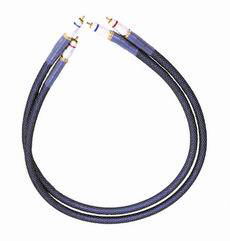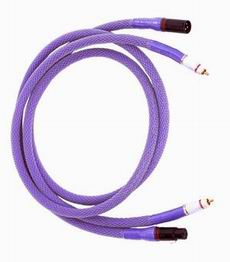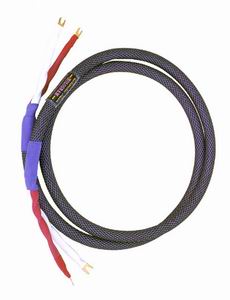Acoustic Zen Hologram Speaker Cable, Silver Reference and Matrix Interconnects
| Acoustic Zen Hologram Speaker Cable, Silver Reference and Matrix Interconnects |
|
Another Perspective |
|
Dan Dzuban |
|
6 August 2002 |
 Specifications
Specifications
Silver Reference Interconnect
7N Zero Crystal Silver
1 meter, w/RCA plug
Retail: $948.00
Matrix Reference Interconnect
6N Zero Crystal Copper with Silver
1 meter, w/RCA plug
Retail: $498.00
Hologram Speaker Cable
8 AWG, 6N Zero Crystal Copper
8 Ft. Mono Pair Retail: $1,048.00
Retail: $1,048.00
Address:
Acoustic Zen Technologies
800 Los Vallecitos Blvd. Suite P
San Marcos, CA 92069
Telephone: (760) 471-4899
Website: www.acousticzen.com
Comrade Appel didn’t mince words in his April 2002 review of Acoustic Zen’s Hologram speaker cable and Krakatoa power cable. So why beat a dead horse? Unlike Mr. Appel, I did not have any exposure to other Acoustic Zen products, so my perspective was not to see whether the company could outdo its earlier designs. Rather, I just wanted to see what all the fuss was about.
products, so my perspective was not to see whether the company could outdo its earlier designs. Rather, I just wanted to see what all the fuss was about.
Buzz, Buzz, Buzz…
One of my pet peeves is the often-misunderstood difference between hype and buzz. The way I see it, buzz is the excitement generated by word of mouth followed by media recognition when a particular product or service is of exceptional merit. Hype is buzz’s evil twin, or maybe hype is Bizarro-world buzz; it is less about genuine excitement, and more about attention, albeit unwarranted. It is instead conjured up, first in public relations or marketing departments and then eventually reaching the media. Buzz is an indication of enduring value, whereas hype is here today and gone tomorrow.
As American consumers, generally we have come to understand the difference between buzz and hype on an intuitive level. Teenagers, however, have not yet honed this skill. An example would be the difference between the Backstreet Boys and James Taylor, or Phantom Menace and the original Star Wars.
Acoustic Zen products have gotten quite a bit of exposure in the audiophile media world lately, including some rave reviews here in the Stereo Times. I could not help but wonder how much was genuine buzz and how much was merely hype. I am happy to report that Acoustic Zen’s cable and interconnects are worthy of their buzz. In fact, I second brother Appel’s enthusiasm.
Humble Beginnings
Initially, all was not so clear-cut. My first impression of the cables was not positive. In fact, out of the box, they sounded horrible. So bad that I really have no recollection of how they sounded other than that they were so glare-ridden and harsh that I could barely stomach to keep them in my system. My only thought at that point was not whether they were worthy of buzz, but if even hype would be unsustainable with sound this bad. Ultimately both the cables and interconnects required an inordinate amount of break in time. Furthermore, the difference in sound was inordinately dramatic. Only after I let them run all day and night for a week did they start to sound bearable, and only after a month did they hint at being worthy of all the press they have garnered.
Robert Lee, of Acoustic Zen suggested that the best way to experience the potential of his cabling was to wire the entire signal chain with his cable. Furthermore, he added that mixing a Matrix Interconnect with a Silver Reference was preferable to going entirely with Silver Reference. Being the bright-eyed, bushy-tailed reviewer that I am, I did just that.
Comparison
I first replaced my reference Monster Cable Sigma Retro Gold interconnects. The Sigmas are a mighty fine sounding cable. Their marketing literature claims that their design was influenced by the golden era of tube gear, giving them a warm, full-bodied sound. I had thought them to be relatively neutral, but compared to the Matrix/Silver Reference combo, the Sigmas did seem to sound a bit tube-like. I didn’t hear a difference in bass, but the Sigmas seemed to possess a bit softer focus than the ‘Zen cables. The ‘Zen’s modus operandi was laser focus coupled with an expansive soundstage. The Sigmas seemed to give sonic images a bit more body, but the Zens presented their images more clearly. I never thought the Sigmas sounded rolled off, but they didn’t seem to have as much air to their highs as did the ‘Zens. The Zens seemed to be a bit crisper sounding, but I can’t say that they were tipped up or hot.
I then replaced my Harmonic Technology Pro 9 speaker cable with the Acoustic Zen Hologram speaker cable. The differences here were a bit more difficult to pick out. I got less of a sense of a difference in tonal character than I did in image character; the Holograms presented a larger and more distinct soundfield. What has always stuck out to me regarding the Harmonic Technology cable was its purity. The Hologram didn’t sound less “pure” when compared to the Harmonic Technology, but purity didn’t seem to be the priority of the Hologram. The purity was there if I listened for it, but unless I was listening for it, the clarity of individual sound sources within the soundstage was what stuck out.
As a Whole
At the level of performance of the Sigmas, the Harmonic Technologies and the ‘Zens, many of the differences are a matter of personal taste rather than an objective “better or worse.” I had been pretty happy with my cables, along with the Bel Canto Evo 200.4 amp and Quad ESL-989 loudspeaker, feeling that my cabling was not a bottleneck to the system’s overall performance. I still feel that they are not a bottleneck per se, but the ‘Zen cables strengthened numerous attributes in my system that are more in tune with my personal preferences. If you want tonal purity, the Quads can give it to you like few others, and both the MC Sigmas and HT Pro 9’s seem to cater to that. However, I found that the Quads are capable of giving me a clearer view into a larger soundstage when paired with the Acoustic Zen cables. For me, this was a good thing, or should I say a “clear benefit.” Similarly, the Quads are extremely transparent, so that while the Sigma and Harmonic Tech cables gave my system a bit more warmth and body, the ‘Zen cables made up for it by being so clean that the harmonic textures of the Evo amp could come through on their own. This was a good thing as well.
The Acoustic Zen cables sit in an interesting market niche. They are expensive enough to be on the cusp of the lunacy/cost-no-object category, which would make them a bargain if they can in fact compete performance-wise in this category. But they are also at the point of inflection for diminishing returns, meaning that in real-world terms you will have to spend much more money to get any even slight increase in performance. I cannot comment on how they stand up to cost-no-object designs; for that I will take Martin at his word. All I can say is that the Acoustic Zen cables and interconnects displaced some top-notch performers in my system, and succeeded in bringing out the best in my system in areas that I thought I had previously pushed to the limit. And that, my friends, is a feat worthy of buzz.
![]()
Don’t forget to bookmark us! (CTRL-SHFT-D)
Stereo Times Masthead
Publisher/Founder
Clement Perry
Editor
Dave Thomas
Senior Editors
Frank Alles, Mike Girardi, Key Kim, Russell Lichter, Terry London, Moreno Mitchell, Paul Szabady, Bill Wells, Mike Wright, Stephen Yan, and Rob Dockery
Current Contributors
David Abramson, Tim Barrall, Dave Allison, Ron Cook, Lewis Dardick, Dan Secula, Don Shaulis, Greg Simmons, Eric Teh, Greg Voth, Richard Willie, Ed Van Winkle, and Rob Dockery
Music Reviewers:
Carlos Sanchez, John Jonczyk, John Sprung and Russell Lichter
Site Management Clement Perry
Ad Designer: Martin Perry





Be the first to comment on: Acoustic Zen Hologram Speaker Cable, Silver Reference and Matrix Interconnects